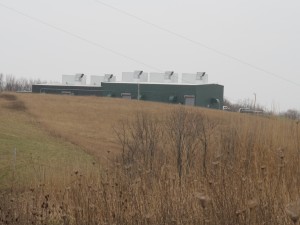Silenced Critic of Dimock's Water Problems Switches to Air Pollution Concerns

Susan Phillips / StateImpactPA
Victoria Switzer in her Carter Road home. As part of her settlement with Cabot Oil and Gas, she can no longer discuss issues of water contamination in Dimock.
One of Dimock’s most outspoken critics of gas drilling in Northeast Pennsylvania says she has shifted gears and changed tactics by networking with industry. Victoria Switzer says she wants to persuade drillers to use the best available technologies that reduce air emissions beyond current regulatory requirements.
Switzer may be best known for her witticisms shaming and ridiculing both local lawmakers and industry representatives who she saw doing little to protect the environment, or the health of local residents. As one of the plaintiffs in a lawsuit against Cabot Oil and Gas, Switzer could be heard speaking out in newspapers, on national TV news programs like CBS’s 60 Minutes, and Josh Fox’s Gasland Part 2. But since settling her lawsuit with Cabot Oil and Gas, Switzer has had to muzzle her thoughts on Dimock’s water issues. So, she says she’s turned to air quality.
“We knew we had hit a wall with the water issues,” said Switzer. “You couldn’t persuade people in a town like this where the hospitals are funded by the gas industry. We more or less gave up on that.”
But Switzer says she’s not giving up on remaining in her home on Carter Road, where she wants to breathe clean air. She’s working with a new organization called Breathe Easy Susquehanna County to limit the air pollutants that could come from dozens of new compressor stations planned for the area.
“As we saw the list of compressor stations, it was like the surprise Christmas package under the tree,” said Switzer. “It’s like a Tim Burton Christmas.”
Switzer says there could be up to 50 compressor stations built in Susquehanna County alone. Compressor stations pressurize gas to move it through pipelines, and in the process generate nitrogen dioxide, an ozone causing gas that can cause respiratory illnesses, and volatile organic compounds. Switzer describes the years fighting gas drilling in Dimock, and being in the national and international spotlight as “an exhausting ordeal.” But so far, she’s optimistic about working with lawmakers and industry to reduce air emissions.
“While statewide emissions from the extraction industry are relatively small compared to some other major sources of air pollution in the state (e.g., SO2 from GW-scale coal-fired power plants), these emissions sources are nevertheless a concern in regions of significant extraction activities. More detailed analyses, including regional data acquisition and consideration of site-specific variability, will be valuable in regions of intense extraction activity and for specific activities and pollutants shown in this analysis to be of most potential concern. And while significant uncertainty may exist for some potential risks of shale gas extraction, under current standard practices, shale gas extraction will be associated with non-trivial air pollution emissions.”
 The Rand Corporation study looked at four sources of regional air pollutants resulting from natural gas production. These include truck traffic, emissions from the well sites during drilling and hydraulic fracturing, the use of diesel engines, fugitive emissions from the wellhead, and emissions associated with the transport of gas via compressor stations.
The Rand Corporation study looked at four sources of regional air pollutants resulting from natural gas production. These include truck traffic, emissions from the well sites during drilling and hydraulic fracturing, the use of diesel engines, fugitive emissions from the wellhead, and emissions associated with the transport of gas via compressor stations.
“It may be hard to limit these emissions through mechanisms such as permitting restrictions, which typically do not apply to mobile and minor stationary sources. Existing regulations may therefore not be well-suited for managing emissions from a substantial number of small-scale emitters. Proposals to aggregate industry sources should be carefully considered in terms of the appropriate unit of aggregation (e.g., by company, by geographic region) and any unintended consequences or perverse incentive they may create.”

















